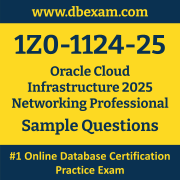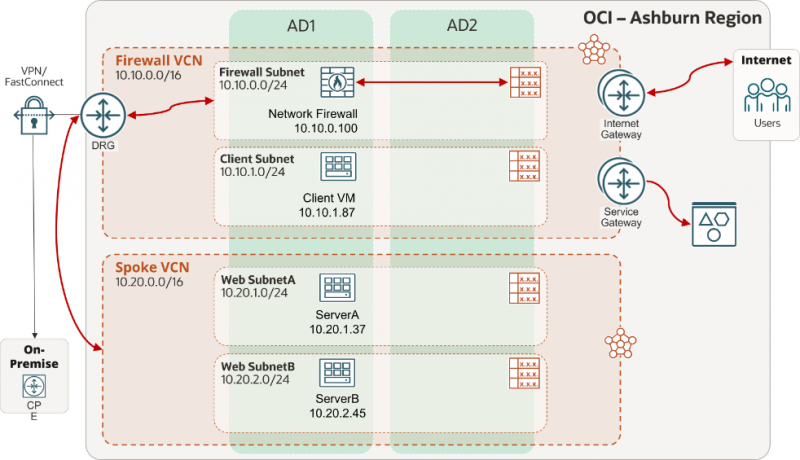01. When setting up the Oracle Cloud Network Load Balancer, what is a backend set, and what does it consist of?
a) A backend set is a group of backend servers that receive incoming traffic from the load balancer. It consists of compute instances, IP addresses, or both.
b) A backend set is a collection of load balancer policies and rules that determine how traffic is distributed among backend servers.
c) A backend set is a list of SSL certificates used for securing incoming traffic to the load balancer.
d) A backend set is a region-specific configuration that allows the load balancer to route traffic to specific geographical locations.
02. Your organization has recently acquired another organization. The acquired organization is also having their workload deployed on Oracle Cloud Infrastructure (OCI) in Tenancy 2. Your workload is deployed in Tenancy 1.
You want to ensure inter-tenancy connectivity between both the organizations' workloads for seamless communication between the applications.
Reference the architecture diagram below:
Which three policies are minimum identity policies needed at the Acceptor side to create a cross-tenancy VCN Peering using remote peering connection?
a) Admit group <acceptor-group-name> of tenancy Acceptor to manage remote-peering-from in compartment <<acceptor-compartment-name>>
b) Define tenancy Acceptor as <acceptor-tenancy-ocid>
c) Admit group <requestor-group-name> of tenancy Requestor to manage remote-peering-to in compartment <<acceptor-compartment-name>>
d) Define group <requestor-group-name> as <requestor-group-ocid>
e) Define tenancy Requestor as <requestor-tenancy-ocid>
f) Define group <acceptor-group-name> as <acceptor-group-ocid>
03. Which of the following connectivity models is suitable if your on-premises or remote data center location is not served by any of Oracle's FastConnect Partners, and you have existing relationships with certain network carriers?
a) FastConnect Private Peering
b) FastConnect with an Oracle Provider
c) FastConnect with a Third-Party Provider
d) FastConnect Colocation with Oracle
04. As a Cloud Network Engineer, you are helping an Oracle Cloud Infrastructure (OCI) customer with their split workload architecture. The customer is planning to run their application on Microsoft Azure, but still given the performance of Oracle databases, they would like to use OCI databases.
The customer is currently evaluating the Interconnect between OCI and Azure and has concerns around where the service would be available and how much latency their application would experience when connecting to its database.
Which of the following statements can accurately assist the customer?
a) The OCI Azure Interconnect offers a guaranteed minimum latency of 2.3 ms.
b) The OCI Azure Interconnect offers different latency values depending on the region and Availability Domains. It is the designer's responsibility to identify the best locations.
c) The OCI Azure Interconnect service is always available where the Fast Connect service is available.
d) The OCI Azure Interconnect service is always available where the Fast Connect service is unavailable.
05. Your enterprise customer's IPv6 policy is to assign a /56 Global Unicast Address (GUA) for a Virtual Cloud Network and the subnet to be /64. How many subnets can we define using this plan?
a) 256
b) 176
c) 1024
d) 512
06. You are facing a problem with network reachability between a couple of resources/compute instances, possibly due to a malware attack on the complex network in Ashburn region.
You did preliminary tests to check the reachability but could not identify the issue. You want to resolve the issue quickly and find out root cause, as the application is not configured with high availability.
After basic troubleshooting, which two Oracle Cloud Infrastructure (OCI) tools can you choose to help you resolve the issue?
a) Use the Inter-Region latency dashboard to get real-time information between the two regions to rule out any issues with OCI backbone.
b) Use Network Visualizer to connect to the endpoints suffering from reachability issues.
c) Use Network Path Analyzer to create a path analysis check and verify the actual network path between two endpoints.
d) Call OCI Customer Support to check the integrity of your resources.
e) Enable full packet capture in the concerned VCN for deeper troubleshooting by launching the Virtual Test Access Point (VTAP) configuration.
07. You have successfully configured a network firewall to inspect N-S traffic and E-W traffic going in and out of the Oracle Cloud Infrastructure (OCI) network, as shown in the architecture diagram.
The Dynamic Routing Gateway (DRG) is correctly configured between the firewall hub Virtual Cloud Network (VCN) and spoke VCN for inter-VCN communication.
The network firewall security policy is configured with 5-tuple security rules, as shown below:
Which two statements are correct with respect to network firewall policy configuration?
a) Network firewall denies ICMP traffic from ServerB to ServerA.
b) Network firewall denies SSH traffic from ServerA to ServerB.
c) Network firewall allows ICMP traffic from ServerB to ServerA.
d) Network firewall allows SSH traffic from ServerA to ServerB.
08. Your information security team has informed you of a compliance policy that prevents outbound connections to the Internet or usage of publicly accessible IP destinations. You are designing your Virtual Cloud Network (VCN) for access to Oracle's Autonomous Data Warehouse service.
Which of the following virtual networking resources should you deploy to achieve this goal?
a) Service Gateway
b) Private Endpoints
c) Network Address Translation Gateway
d) Internet Gateway
09. You have an instance rpc01 in a private subnet with a CIDR of 10.0.0.0/24 in the home region Mumbai and another instance rpc02 in a different private subnet with a CIDR of 192.168.0.0/24 in the Hyderabad region.
The instances are configured to sync data from an object storage bucket but for some reason the sync has suddenly stopped working.
Which statement is correct considering you use cloud shell ephemeral network to quickly log in and troubleshoot these instances?
a) rpc01 and rpc02 are both accessible.
b) rpc01 and rpc02 are both inaccessible.
c) rpc01 is accessible.
d) rpc02 is accessible.
10. A company is attempting to configure transit routing through the Oracle Cloud Infrastructure (OCI) Phoenix region to resources located in the OCI Ashburn region. Currently, they have connectivity between their on-premises data center and the OCI Phoenix region using a FastConnect LAG.
What needs to happen to ensure network traffic will work bi-directionally between the on-premises data center and the OCI Ashburn region?
a) Associate Phoenix Virtual Cloud Network (VCN) with the Phoenix Dynamic Routing Gateway (DRG) and provide a static route towards the Ashburn VCN CIDR using a newly created Remote Peering Connection. Add a static route in the Ashburn VCN to use the Phoenix VCN as its next-hop for the data center CIDR.
b) Create a cross-region Virtual Cloud Network (VCN) attachment from the Phoenix VCN to the Ashburn Dynamic Routing Gateway (DRG). Export the FastConnect attachment for the DRG Route Table used by the Remote Peering Connection (RPC). Export the RPC attachment into the DRG Route Table used by the FastConnect LAG.
c) Modify the Autogenerated Import Route Distributions for Virtual Cloud Network (VCN) attachments to remove the match criteria for ALL attachments and only include the Remote Peering Connection (RPC) and the FastConnect LAG as its match criteria.
d) Create a new Remote Peering Connection between the OCI Phoenix Region and the OCI Ashburn Region. Import the FastConnect attachment for the Dynamic Routing Gateway (DRG) Route Table used by the Remote Peering Connection (RPC). Import the RPC attachment into the DRG Route Table used by the FastConnect LAG.
 The Oracle Cloud Infrastructure Networking Professional (1Z0-1124-25) Sample Question Set is designed to help you prepare for the Oracle Cloud Infrastructure 2025 Certified Networking Professional certification exam. To become familiar with the actual Oracle Certification exam environment, we suggest you try our Sample Oracle 1Z0-1124-25 Certification Practice Exam.
The Oracle Cloud Infrastructure Networking Professional (1Z0-1124-25) Sample Question Set is designed to help you prepare for the Oracle Cloud Infrastructure 2025 Certified Networking Professional certification exam. To become familiar with the actual Oracle Certification exam environment, we suggest you try our Sample Oracle 1Z0-1124-25 Certification Practice Exam.


